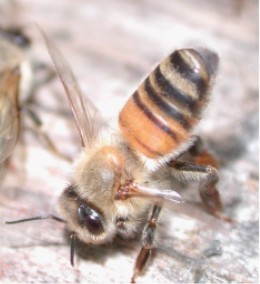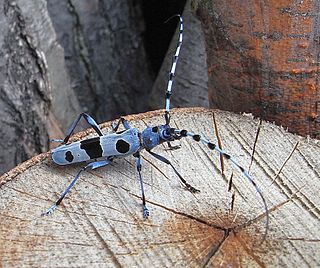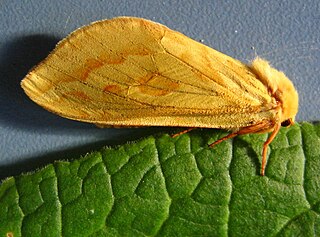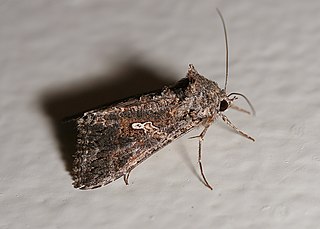
A pheromone is a secreted or excreted chemical factor that triggers a social response in members of the same species. Pheromones are chemicals capable of acting like hormones outside the body of the secreting individual, to affect the behavior of the receiving individuals. There are alarm pheromones, food trail pheromones, sex pheromones, and many others that affect behavior or physiology. Pheromones are used by many organisms, from basic unicellular prokaryotes to complex multicellular eukaryotes. Their use among insects has been particularly well documented. In addition, some vertebrates, plants and ciliates communicate by using pheromones. The ecological functions and evolution of pheromones are a major topic of research in the field of chemical ecology.

Antennae, sometimes referred to as "feelers", are paired appendages used for sensing in arthropods.

The ghost moth or ghost swift is a moth of the family Hepialidae. It is common throughout Europe, except for the far south-east.

The brown-banded cockroach is a species of small cockroach, measuring about 10 to 14 mm long and the most well-known in the genus Supella. It is tan to light brown and has two light-colored bands across the wings and abdomen, which may sometimes appear to be broken or irregular but are quite noticeable. The bands may be partly obscured by the wings. The male has wings that cover the abdomen, while the female has wings that do not cover the abdomen completely. The male appears more slender than the female, the female appears wider.

The Indianmeal moth, also spelled Indian meal moth and Indian-meal moth, is a pyraloid moth of the family Pyralidae. Alternative common names are hanger-downers, weevil moth, pantry moth, flour moth or grain moth. The almond moth and the raisin moth are commonly confused with the Indian-meal moth due to similar food sources and appearance. The species was named for feeding on Indian meal or cornmeal, and does not occur natively in India. It is also not to be confused with the Mediterranean flour moth, another common pest of stored grains.

The cabbage looper is a medium-sized moth in the family Noctuidae, a family commonly referred to as owlet moths. Its common name comes from its preferred host plants and distinctive crawling behavior. Cruciferous vegetables, such as cabbage, bok choy, and broccoli, are its main host plant; hence, the reference to cabbage in its common name. The larva is called a looper because it arches its back into a loop when it crawls.

The genus Calyptra is a group of moths in subfamily Calpinae of the family Erebidae. They are a member of the Calpini tribe, whose precise circumscription is uncertain but which includes a number of other fruit-piercing or eye-frequenting genera currently classified in Calpinae.

The diamondback moth, sometimes called the cabbage moth, is a moth species of the family Plutellidae and genus Plutella. The small, grayish-brown moth sometimes has a cream-colored band that forms a diamond along its back. The species may have originated in Europe, South Africa, or the Mediterranean region, but it has now spread worldwide.

The Calpini are a tribe of fruit-piercing moths in the family Erebidae; formerly they were included in the family Noctuidae. The proboscis of the adult moths of this tribe is pointed and barbed, allowing the moth to pierce the skin of fruit to drink the juice. The vampire moths in the genus Calyptra can pierce mammal skin to drink blood.

Spodoptera littoralis, also referred to as the African cotton leafworm or Egyptian cotton leafworm or Mediterranean brocade, is a species of moth in the family Noctuidae. S. littoralis is found widely in Africa, Mediterranean Europe and Middle Eastern countries. It is a highly polyphagous organism that is a pest of many cultivated plants and crops. As a result, this species was assigned the label of A2 quarantine pest by the EPPO and was cautioned as a highly invasive species in the United States. The devastating impacts caused by these pests have led to the development of both biological and chemical control methods. This moth is often confused with Spodoptera litura.

Utetheisa ornatrix, also called the ornate bella moth, ornate moth, bella moth or rattlebox moth, is a moth of the subfamily Arctiinae. It is aposematically colored ranging from pink, red, orange and yellow to white coloration with black markings arranged in varying patterns on its wings. It has a wingspan of 33–46 mm. Moths reside in temperate midwestern and eastern North America as well as throughout Mexico and other parts of Central America. Unlike most moths, the bella moth is diurnal. Formerly, the bella moth or beautiful utetheisa of temperate eastern North America was separated as Utetheisa bella. Now it is united with the bella moth in Utetheisa ornatrix.
An organism is said to be sexually dimorphic when male and female conspecifics have anatomical differences in features such as body size, coloration, or ornamentation, but disregarding differences of reproductive organs. Sexual dimorphism is usually a product of sexual selection, with female choice leading to elaborate male ornamentation and male-male competition leading to the development of competitive weaponry. However, evolutionary selection also acts on the sensory systems that receivers use to perceive external stimuli. If the benefits of perception to one sex or the other are different, sex differences in sensory systems can arise. For example, female production of signals used to attract mates can put selective pressure on males to improve their ability to detect those signals. As a result, only males of this species will evolve specialized mechanisms to aid in detection of the female signal. This article uses examples of sex differences in the olfactory, visual, and auditory systems of various organisms to show how sex differences in sensory systems arise when it benefits one sex and not the other to have enhanced perception of certain external stimuli. In each case, the form of the sex difference reflects the function it serves in terms of enhanced reproductive success.
Calyptra eustrigata is a moth of the family Erebidae, found in Sri Lanka and Malaysia. It has been reported as exhibiting parasitic blood-sucking behavior.
Odour is sensory stimulation of the olfactory membrane of the nose by a group of molecules. Certain body odours are connected to human sexual attraction. Humans can make use of body odour subconsciously to identify whether a potential mate will pass on favourable traits to their offspring. Body odour may provide significant cues about the genetic quality, health and reproductive success of a potential mate.

Hair-pencils and coremata are pheromone signaling structures present in lepidopteran males. Males use hair-pencils in courtship behaviors with females. The pheromones they excrete serve as both aphrodisiacs and tranquilizers to females as well as repellents to conspecific males. Hair-pencil glands are stored inside the male until courtship begins, at which point they are forced out of the body by sclerotized levers present on the abdomen. Coremata are very similar structures. Their exact definition is confused by early descriptions but they are more specifically defined as the internal, glandular, eversible structures that bear the hair-pencils and can be voluntarily inflated with hemolymph or air.
Ostrinia scapulalis, the adzuki bean borer or adzuki bean worm, is a species of moth in the family Crambidae. It was described by Francis Walker in 1859. It is one of 20 moths in the genus Ostrinia and is of Eurasian origin. The larvae have a gray mid-dorsal line and can be light pink or beige. The adult adzuki bean borer has a yellowish-brown forewing with jagged lines and variable darker shading, with a wingspan that ranges from 20 to 32 mm. The moths of this species are nocturnal and tend to be attracted to light.
The lateral horn is one of the two areas of the insect brain where projection neurons of the antennal lobe send their axons. The other area is the mushroom body. Several morphological classes of neurons in the lateral horn receive olfactory information through the projection neurons.

Ostrinia furnacalis is a species of moth in the family Crambidae, the grass moths. It was described by Achille Guenée in 1854 and is known by the common name Asian corn borer since this species is found in Asia and feeds mainly on corn crop. The moth is found from China to Australia, including in Java, Sulawesi, the Philippines, Borneo, New Guinea, the Solomon Islands, and Micronesia. The Asian corn borer is part of the species complex, Ostrinia, in which members are difficult to distinguish based on appearance. Other Ostrinia such as O. orientalis, O. scapulalis, O. zealis, and O. zaguliaevi can occur with O. furnacalis, and the taxa can be hard to tell apart.

Insect olfaction refers to the function of chemical receptors that enable insects to detect and identify volatile compounds for foraging, predator avoidance, finding mating partners and locating oviposition habitats. Thus, it is the most important sensation for insects. Most important insect behaviors must be timed perfectly which is dependent on what they smell and when they smell it. For example, olfaction is essential for locating host plants and hunting prey in many species of insects, such as the moth Deilephila elpenor and the wasp Polybia sericea, respectively.

The white worm beetle is a species of beetle in the family Scarabaeidae. It is the only species in the genus Hylamorpha. This beetle is native to South America, particularly in regions of Argentina, Brazil, and Uruguay.














